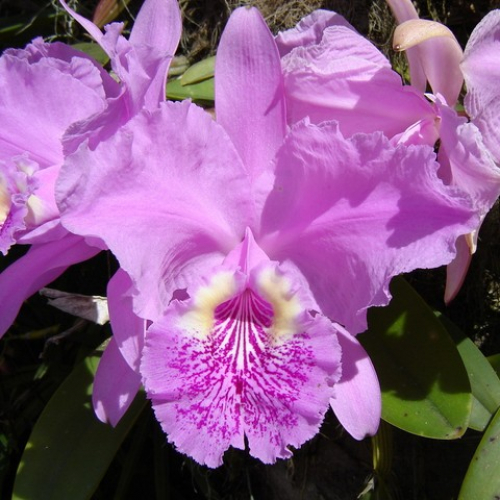Indoor plants Cattleya

Description
Special Features of Cattleya
Cattleya is a popular plant of the orchid family Orchidaceae native to Central America. This is an epiphyte that in its natural habitat grows on trees clinging to branches.
Cattleya is impressive, with large showy bright-coloured and intricate-shaped flowers. It can have two types of flowers, single or double. A typical flower has several frilly-margined petals and a showy lanceolate lip. The colouring, depending on the variety, is varied, from conservative solid to playful bright, with contrasting specks.
The genus Cattleya currently contains over fifty known species and a wide range of hybrids that are continually selected specifically for the flower trade. You can easily find Cattleya in a flower shop or order at an online plant catalogue for home delivery. You will surely find the variety that will satisfy even the most refined and sophisticated taste because you can choose from a large variety of flowers, from miniature to over 15 centimetres long and from a variety of saturated colours. However, it will be difficult to find a plant with true blue and black flowers.
Cut flowers last for several weeks and give off a distinctive sweet smell.
The plant care requires experience and certain skills. Even experienced growers often have problem with flowering. In such cases, be patient and experiment with conditions and care. However, if you want your experiments to be a success, you should know and follow the basic rules of growing this amazing orchid.
The Secrets to Successfully Growing Cattleya
Cattleya needs bright filtered light for healthy growth and flowering. Ideally, the plant should be protected from the bright midday sun and get full light exposure from 9 a.m. to noon. Darkened leaves can be a warning sign indicating low light. Direct sunlight, on the contrary, can cause leaf yellowing and burn, so a location near the eastern or western exposure window is best.
It is essential to provide favourable environment for your plant. The soil should not be soggy. It is even recommended to use natural dessicators like spruce or fir bark. However, neither this additional precaution nor a good drainage will help to cure the consequences of overwatering. Waterlogging can cause root rot and green mold. It is best to water once in three days in the summer and once a week in the winter with lime-free water. Allow the soil to dry up between the waterings.
Humidity should be high enough, and in the summer you can mist the plant with warm lime-free water.
The right temperature is the key to Cattleya's successful growth. The best temperatures are 24-29 C during the daytime 15-18 C at night. The plant can survive occasional temperature variations if they are not too frequent.
Cattleya is responsive to fertilizers. You can use nitrogen fertilizer throughout the year, even during the resting period.
Repot the plant as necessary, for example, when rootbound or when overwatering has caused soil acidification, but not more than once every 2- 3 years. In case of soil acidification, though, repot immediately. Use the classical potting mix for epiphytic orchids with spruce, pine, or fir bark.
Cattleya is propagated by division when it starts growing. Cut the tuber between the two pseudobulbs and plant in individual pots.
Potential Problems
Constant temperature changes are a threat to the plant. Regular exceeding the temperature limits could cause serious growth problems and result in irreversible consequences.
New growth starting during dormancy is not good for the plant. An early start can bring down the vegetation and flowering cycle. To avoid problems, do not mist the leaves or overfeed the plant in the winter. Place it in a moderately bright, cool place until the late autumn.
Do not repot your Cattleya more frequently than required. The plant is sensitive to repotting.
Cattleya can be affected by thrips, aphids, scale insects, and spider mites. If you discover pests, immediately take measures to control. In the Garden Encyclopaedia at procvetok.com, you can always find tips on what to do in different situations and get advice from more experienced visitors and plant experts.







 334
334







